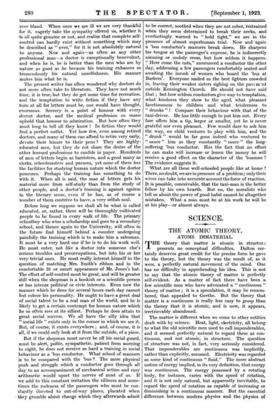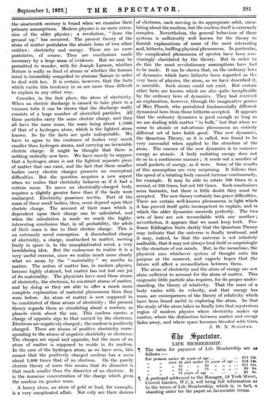SCIENCE.
THE ATOMIC THEORY.
ATOMS IMMATERIAL. THE theory that matter is atomic in structure presents no conceptual difficulties. Dalton cer- tainly, deserves great credit for the precise form he gave to the theory, but the theory was the result of, as it were, a perfectly natural movement of the mind. One has no difficulty in apprehending his idea. This is not to say that the atomic theory of matter is perfectly self-evident. As a matter of fact there have been a few scientific men who have advocated a " continuous " theory of matter ; it is a speculation, it may be remem- bered, that appealed to Goethe. But the theory that matter is a continuum is really less easy to grasp than the theory that it is atomic, and is now, it appears, irretrievably abandoned.
The matter is different when we come to other entities dealt with by science. Heat, light, electricity, all belong to what the old scientific men used to call imponderables, and it seemed perfectly natural to regard these as con- tinuous, and not atomic, in structure. The question of structure was not, in fact, very seriously considered. That imponderables are continuous was implicitly, rather than explicitly, assumed. Electricity was regarded as some kind of continuous "fluid." The more abstract notion of energy implied, in its very definition, that energy was continuous. The energy possessed by a rotating body, for instance, varies with the speed of rotation, and it is not only natural, but apparently inevitable, to regard the speed of rotation as capable of increasing or diminishing in a continuous manner. But the essential difference between modern physics and the physics of the nineteenth century is found when we examine their primary assumptions. Modern physics is no mere exten- sion of the older physics ; a revolution, "from the ground .up," has occurred. The present theory of the atom of matter postulates the atomic form of two other entities : electricity and energy. These are no mere postulates, of course. They are conclusions made necessary by a large mass of evidence. But we may be permitted to wonder, with Sir Joseph Larmor, whether Nature is really So fond of atoms or whether the human mind is irresistibly compelled to atomize Nature in order to deal with her. . It is certain, however, that the facts which excite this tendency in us are more than difficult to explain in any other way.
Consider, in the first place, the atom of electricity. When an electric discharge is 'caused to take place in a Vacuum tube it can be shown that the discharge really consists of a large number of electrified particles. All these particles carry the same electric charge, and they all have the same mass, the mass being about 1/1800 of that of a hydrogen atom, which is the lightest atom known. So far the facts are quite indisputable. We have to agree to the existence of bodies very much smaller than hydrogen atoms, and carrying an invariable electric charge. It might be thought that there is nothing radically new. here. We have merely to suppose that a hydrogen atom is not the lightest separate piece of matter that can exist, and the fact that these smaller bodies carry electric charges presents no conceptual difficulties. But the question acquires a new aspect when we realize that electricity behaves as if it had a certain mass. To move an electrically-charged body requires a • slightly greater force than if the body were uncharged. Electricity possesses inertia. Part of the mass of these small bodies, then, must depend upon their electric charge. The amount of their mass which is dependent upon their charge can be calculated, and when the calculation is made we reach the highly- interesting conclusion that, in all probability, the whole of their mass is due to their electric charge. This is an extremely novel conception. A disembodied charge of electricity, a charge, unattached to matter, moving freely in space is, to the unsophisticated mind, a very bewildering idea. But the endeavour to realize• it is a very useful exercise, since we realize much more clearly what we mean by the " materiality " we ascribe to matter. The notion of matter has, in modern physics, become highly abstract, but matter has not lost one jot of its materiality. The physicists have used these atoms of electricity, the electrons, to construct atoms of matter, and by doing so they are able to offer a much more complete explanation of material phenomena than they .were before. An atom of matter is now supposed to be constituted of these atoms of electricity ; the present theory regards them as circulating about a nucleus, as planets circle about the sun. This nucleus carries a charge of opposite sign to that carried by the electrons. .Electrons are negatively charged ; the nucleus is positively charged. There are atoms of positive electricity corre- sponding to the atoms of negative electricity or electrons. The charges are equal and opposite, but the mass of an atom of matter is. supposed to reside in its nucleus.
• In the case of the hydrogen atom, as we have seen, this means that the positively charged nucleus has a mass about 1,800 times that of an electron. On the purely electric theory of mass this means that its diameter is that much entailer than the diameter of an electron. It is the immense concentration of the charge which gives .the nucleus its greater mass.
A heavy atom, an atom of gold or lead, for example, is a very complicated affair. Not only are there dozens of electrons, each moving .in its appropriate orbit, circu- lating about the nucleus, but the nucleus itself is extremely complex. Nevertheless, the general behaviour of these systems is sufficiently well known for the theory to furnish explanations of some of the most interesting and, hitherto, baffling physical phenomena. In particular, the complicated phenomena of spectra have been con- vincingly elucidated by the theory. But in order to do this the most revolutionary assumptions have had to be made. It can be shown that, on the ordinary laws of dynamics which have, hitherto been regarded as the very basis of physics, the atom, as we have described it, is unstable. Such atoms could not exist. But certain other facts are known which are also quite inexplicable by the ordinary laws of dynamics. They had received an explanation, however, through the imaginative genius of Max Planck, who postulated fundamentally different dynamical laws from those hitherto accepted. It appears that the ordinary dynamics is good enough as long as we are dealing with matter "in bulk," but that when we come to atomic or sub-atomic phenomena an entirely different set of laws holds good. This new dynamics, the Quantum Theory, as it is called, was found to be very successful when applied to the structure of the atom. The essence of the new dynamics is to conceive energy as atomic. A body radiating energy does not do so in a continuous manner ; it sends out a number of small packets of energy, as it were. Some of the results of this assumption are very surprising. It follows that the speed of a rotating body cannot increase continuously, for example. It may be able to rotate 100 times in a second, or 102 times, but not 101 times. Such conclusions seem fantastic, but there is little doubt they must be accepted. The new theory certainly has grave difficulties. There are certain well-known phenomena in light which it has proved itself quite incompetent to explain, and in which the older dynamics succeeds perfectly. The two sets of laws are not reconcilable with one another ; nevertheless, it appears that we must keep both. Pro- fessor Eddington hints darkly that the Quantum Theory may indicate that the universe is finally irrational, and it may, indeed, be that the universe is not infinitely malleable, that it may not always lend itself so surprisingly to the structure of our minds. But, in the meantime, the physicist uses whichever system of thought suits his purpose at the moment, and vaguely hopes that the future will affect a reconciliation between them.
The atom of electricity and the atom of energy are not alone sufficient to account for the atom of matter. This enigmatic little particle also requires, for its proper under- standing, the theory of relativity. That the mass of a body varies with its velocity, and that energy has mass, are consequences of the theory of relativity which have been found useful in exploring the atom. So that the study of the atom takes us finally into that mysterious region of modern physics where electricity makes up matter, where the distinction between matter and energy fades away, and where space becomes blended with time.
J. W. N. SULLIVAN.



































 Previous page
Previous page